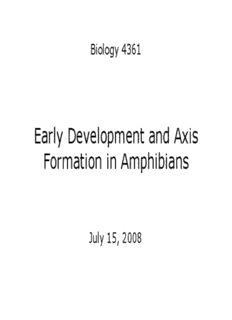
10. Early Amphibian Development PDF
Preview 10. Early Amphibian Development
Biology 4361 Early Development and Axis Formation in Amphibians July 15, 2008 The Amphibian Model Common vertebrate (e.g. Rana, Xenopus) Manipulable, observable (i.e. large eggs and embryos) 1) How are the body axes established? How do relatively homogeneous cells (i.e. zygotes) establish polarity (complexity from simplicity)? 2) How are the germ layers determined? How do zygotes send their cellular progeny (i.e. blastomeres) down pathways toward different fates? 3) How is development organized in a regulative system? Amphibian Development Overview Fertilization, cortical rotation Cleavage Gastrulation Axis and germ layer determination The “Organizer” Inductions: Mesoderm Dorsal/organizer Ectoderm Axes Summary (Photo by Harland lab/UC Berkeley) Cortical Rotation Fertilization – animal hemisphere Microtubular network originates at fertilization point Holoblastic (complete cleavage) Species Cleavage Yolk echinoderms, Radial classification amphioxis Cleavage Patterns annelids, molluscs, Spiral flatworms Isolecithal tunicates Bilateral mammals, nematode Rotational Mesolecithal amphibians Displaced radial Meroblastic (incomplete cleavage) cephalopod molluscs Bilateral Telolecithal fish, reptiles, birds Discoidal Centrolethical most insects Superficial Unequal Radial Holoblastic Cleavage Cell cycles regulated by mitosispromoting factor (MPF) no G phases … until midblastula transition promoters demethylated (i.e. derepressed) transcription factors formed in vegetal cytoplasm embryonic control of development Mechanics of Gastrulation Formation of the dorsal lip vegetal rotation invagination of bottle cells involution of marginal zone cells Involuting Marginal Zone Mechanics of Gastrulation 2 Formation of the dorsal lip vegetal rotation invagination of bottle cells involution of marginal zone cells motive force (D) Xenopus Gastrulation Cell Movements during Gastrulation Movements invagination involution epiboly (animal cap) intercalation and convergent extension migration
Description: